
History:
Historical Overview (A brief history of Panama)
History of the Panama Railroad
The Panama Railroad and the US Mail
The Panama Railroad and the Panama Canal
The Panama Canal Towing Locomotives
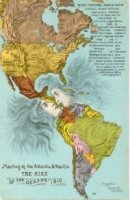 The Kiss of the Oceans Meeting of the Atlantic and Pacific Artist: C.A.DeLisle, 1910 "Here the oceans twain have waited All the ages to be mated,__ Waited long and waited vainly, Though the script was written plainly: This, the portal of the sea, Opes for him who holds the key; Here the empire of the earth Waits in patience for its birth." --James Jeffrey Roche |
THE HISTORY OF the Panamanian isthmus,
since Spaniards first landed on its shores in 1501, is a
tale of treasure, and treasure seekers, of clashes among
empires, nations, and cultures; of adventurers and
builders; of magnificent dreams fulfilled and simple
needs unmet."O Land of Love and Pleasure, There is a breath of ancient poetry about Panama--this slender stip of land which nature forged for her uses during some crises in her conflict with time and change. ---- Thus it was found by Columbus, washed on the eastern shores by the turbulent tides of the Atlantic, and by Balboa, looking toward the sunset with the placid Pacific flowing past. There is perhaps no region in the world, of similar areas, which has been allotted so important a role in the world's commerce, nor is there a region of similar area, that possesses so many places replete with history, romance and tropical beauty -- as the Isthmus of Panama. |
|
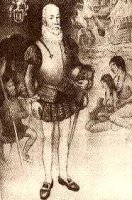
Rodrigo de Bastidas |
Columbus
and the Discovery of Panama: Rodrigo de Bastidas, a wealthy notary public from Seville, was the first of many Spanish explorers to reach the isthmus discovering the islands of San Blas off the coast of Panama. Sailing westward from Venezuela in 1501 in search of gold, he explored some 150 kilometers of the coastal area before heading for the West Indies.
|
|
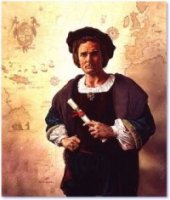 Cristopher Columbus "Push off, and sitting well in order, smite The surrounding furrows; for my purpose holds To sail beyond the sunset, and the baths Of all the Western stars, until I die." --Alfred Tennyson 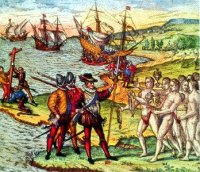 Friendly Indians |
A year later, Christopher Columbus, on
his fourth voyage to the New World, touched several
points on the isthmus. Christopher Columbus was the first
white man to visit Panama's mainland.
He visited Navy Bay which encircles the island of Manzanilla on which the city of Colon is located. As the island presented a very depressing aspect, Columbus did not consider effecting a settlement at this point, sailing away to a point fifty miles west of Colon and made a settlement which he named Belen. Here he left his brother Diego with one hundred men. The settlers remained there for some time and the sad story of the privations, hardships, and the final destruction of the entire group by the Indians, is one of the most pathetic in the history of early colonization. The Indians in the region of Belen at the time of Columbus' discovery were very friendly; they wore plates of gold suspended around their necks and weighted their fishing nets with gold nuggets. When Columbus returned to Spain, his report was that Panama was the richest of all his discoveries. |
|
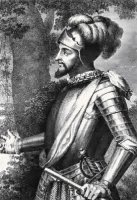 Vasco Núñez de Balboa "Before him spread no paltry lands To wrest with spoils from savage hands; But, fresh and fair, an unknown world Of mighty sea and shore unfurled." --Nora Perry. 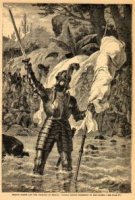 Vasco Núñez de Balboa takes possession of the South Sea "When, with eagle eye, he stared at the Pacific, And all his men Gathered round him, with a wild surmise, Silent, upon a peak of Darien." 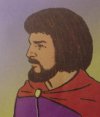 Pedro Arias Davila 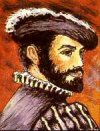 Diego De Nicuesa 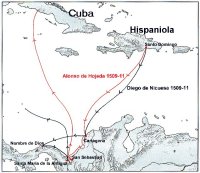 Route followed by Nicuesa 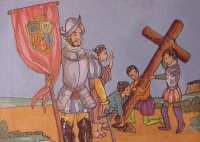 Foundation of Nombre de Dios 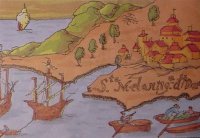 Santa Maria la Antigua del Darien |
Balboa and
the discovery of the Pacific Ocean: Vasco Núñez de Balboa, a member of Bastidas's crew, had settled in Hispaniola (present-day Dominican Republic and Haiti) but stowed away on a voyage to Panama in 1510 to escape his creditors. At that time, about 800 Spaniards lived on the isthmus, but soon the many jungle perils, doubtless including malaria and yellow fever, had killed all but 60 of them. Finally, the settlers at Antigua del Darién (Antigua), the first city to be duly constituted by the Spanish crown, deposed the crown's representative and elected Balboa and Martin Zamudio co-mayors. Balboa proved to be a good administrator. He insisted that the settlers plant crops rather than depend solely on supply ships, and Antigua became a prosperous community. Like other conquistadors, Balboa led raids on Indian settlements, but unlike most, he proceeded to befriend the conquered tribes. He took the daughter of a chief as his lifelong mistress. The Indians with whom Balboa became friendly told him of a great sea just a few days travel away, and it was his burning desire to find this sea that inspired Balboa to march into the wild, steaming jungles of Panama. On September 1, 1513, Balboa set out with 190 Spaniards--among them Francisco Pizarro, who later conquered the Inca Empire in Peru--a pack of dogs, and 1,000 Indian slaves. After twentyfive days of hacking their way through the jungle, the party gazed on the vast expanse of the Pacific Ocean. Balboa, clad in full armor, waded into the water and claimed the sea and all the shores on which it washed for his God and his king. His discovery would alter history and finally lead to the building of the Panama Canal. Balboa returned to Antigua in January 1514 with all 190 soldiers and with cotton cloth, pearls, and 40,000 pesos in gold. Meanwhile, Balboa's enemies had denounced him in the Spanish court, and King Ferdinand appointed a new governor for the colony, then known as Castilla del Oro. The new governor, Pedro Arias de Avila, also became known as "Pedrarias the Cruel." The appointment in 1514 of Pedrarias Dávila as governor of the regions discovered and partly occupied by Balboa, and his appearance on the coast of Darien with a large armament, at once gave rise to trouble. Arias was an aged man of mediocre attainments, jealous, deceitful, and vindictive. Balboa was generous, careless, and over-confident in the merits of his achievements, and was no match for the intrigues that forthwith began against him. To mask his sinister designs Arias gave one of his daughters to Balboa in marriage. The latter was allowed to continue his explorations while Arias and the Licentiate Gaspar de Espinosa were slowly tightening a net of true and false testimony around him under cover of the inevitable Residencia. The Crown gave Balboa the title of Adelantado of the South Sea, Governor of Coyba and of what subsequently became the district of Panama, but Arias and his agents understood how to reduce these titles to empty honours. Quevedo, Bishop of Castilla del Oro, was Balboa's sincere friend and assisted him, but with Quevedo's departure for Spain the case was lost. Fearful lest the bishop's appeal for his friend might result against Arias and his party, the Residencia was at once converted into criminal proceedings, death sentence hastily pronounced, and Balboa beheaded for high treason in 1517 at Darien. One of the main pretexts for the sentence was Balboa's action towards Enciso and Nicuesa. Nombre de Dios In 1510 Diego de Nicuesa, another Spanish explorer, established the settlement of Nombre de Dios. Nicuesa had his fill of the country west of Belen, so he followed the coast to the eastward. A sailor who had been with Columbus, told Nicuesa that they must be in the neighborhood of a fine harbor, named Puerto Bello, where the old Admiral had left an anchor sticking in the sand, near which was a spring of cool water at the foot of a large tree. After some search, Puerto Bello was entered, and the anchor, spring, and tree found. The Spaniards foraged for something to eat, when the Indians killed twenty of their number and drove the rest back in confusion. Discouraged at the prospect of making a settlement at Puerto Bello, the governor resumed his search to the eastward. After sailing about seven leagues, they came to a harbor. The country looked fruitful and the shore seemed to present a favorable location for a fortress. "Paremos aqui, en nombre de Dios!" (Let us stop here, in the name of God) exclaimed Nicuesa. His followers, seeing a lucky augury in his words, decided to call the place Nombre de Dios, even before a landing was effected. Because of the presence of bellicose Indians, the colony was moved, at the instigation of Balboa, northeast across the Atrato River and was given the name Santa María la Antigua del Darién. It became the first permanent settlement on the isthmus. Colony of Panama Panama (the first European settlement on the west coast of the hemisphere), became the centre of commercial activity and the springboard for the conquest of Peru. The colony, became an important part of Spain's mercantile system, attaining the rank of audiencia in 1538. |
|
|
[Next:Historical Overview (part II)]
[Home] [ History | Maps | Picture Galleries | Amazing Facts | Panama Railroad Travelogues ] [ Quotes | Present | Future | Links | Credits | Site-map | News ] |
||
|
|
||